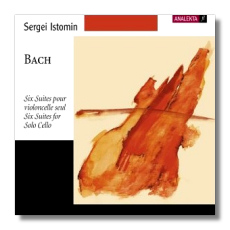
The Internet's Premier Classical Music Source
Related Links
- J.S. Bach Reviews
- Latest Reviews
- More Reviews
-
By Composer
-
Collections
DVD & Blu-ray
Books
Concert Reviews
Articles/Interviews
Software
Audio
Search Amazon
Recommended Links
Site News
 CD Review
CD Review
Johann Sebastian Bach

Suites for Solo Cello
- Suite #1 in G minor, BWV 1007
- Suite #2 in D minor, BWV 1008
- Suite #3 in C Major, BWV 1009
- Suite #4 in E Flat Major, BWV 1010
- Suite #5 in C minor, BWV 1011
- Suite #6 in D Major, BWV 1012
Sergei Istomin, baroque cello
Analekta fleur de lys FL23114-5 DDD 2CDs 131:22
It seems to have become fashionable of late to point out that Bach's great cello suites consist, for the most part, of movements whose titles are those of dances. This statement of the obvious is presumably meant to imply that the element of the dance has previously been overlooked in performance and recording of these sublime masterpieces.
The result has been, or so it seems, a number of issues of the works in which the dance has tended to dominate at the expense of all else: emotion and intellect being the two prime casualties.
Since I first became acquainted with this music, over thirty years ago, I have always considered that the suites are, aside from anything else, intensely cerebral music. So much of the harmony and counterpoint is implied rather than spelled out, that the listener must bring a good deal to the table. This music will never become popular in the way that Vivaldi's Four Seasons is (or are, if you prefer).
Sergei Istomin, a member of Tafelmusik, plays the first five suites on a 1994 copy, by Dominik Zuchowicz, of a 1739 Montagnana, and the sixth on a mid-18th century Bohemian five-stringed piccolo cello, both tuned to A=415; all six suites are heard in accounts for which the word "thoughtful" seems particularly apposite.
Which is not to suggest any lack of intensity, or that these are withdrawn "inner-directed" (to use the language of pop psychology) performances; far from it, they are as outgoing as anyone could wish. And there is rhythmic vitality to spare.
But one is continually conscious that there is a thinking musician at work here.
There are many felicitous touches and numerous places at which Istomin employs a tasteful rubato and vibrato, all of which impart a singular freshness to the music even to those of us who think we know the music inside out. Unusually, these do not tend to become tiresome on repeated hearings.
In fact rather the reverse: on each successive hearing of these superb performances (I have in fact lost count of how many times I've listened, these discs are decidedly addictive) I have heard more detail than before. A sign, surely, of truly exceptional playing.
Istomin is - unlike some other notable performers - consistently successfwith all six suites, from his reflective First to the wonderfully vital Sixth. My own favourite, the C Major, receives a performance worthy to set in my personal pantheon next to Casals and Starker.
Istomin's sound, too, is very fine. Decidedly "authentic", yet without a hint of what the late Neville Cardus called "the wasp-in-the-window effect". It is a rich, vibrant sound, yet clear and bright. A model, in fact, of what period performance can be at its very best.
The recording, too, is warm and resonant, but not too much so; the cello sound is never buried under a blanket of reverberance, despite the church acoustic employed.
The Canadian label Analekta seems, unfortunately, to be successful at one other thing: hiding its light under a bushel. They should have trumpeted these recordings from the rooftops. Instead, I heard about them at secondhand, via a friend in the early music business.
An exceptionally successful survey of the suites, then. Highly recommendable whether or not you would normally be drawn to period performances of Bach. This set would make a fine first choice - although there are so many topflight recordings that it is hard to place one above all the others (always excepting Casals, of course, but he is a special case).
But, even if you already have a set with which you are happy, I urgently recommend you to investigate this set. And I'm not just saying that because he's a fellow Canadian.
Copyright © 1998, Deryk Barker


















